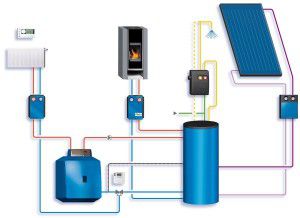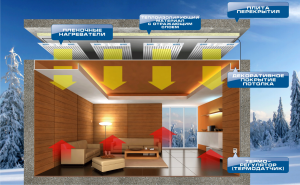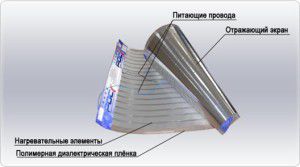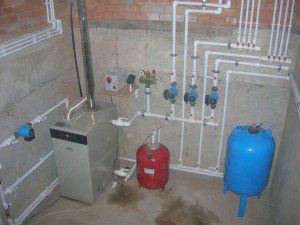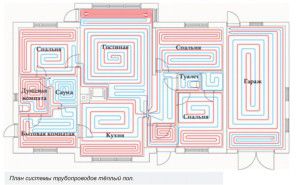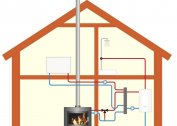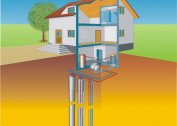Heating should be not only efficient, but also economical. To contribute to the growth of this indicator should the latest heating technology of a private house and its installation. Their main characteristic is the efficiency indicator. But do not forget about minimizing operating costs.
Principles of New Heating Techniques
Any innovative technologies in heating should improve the system, its performance and operating comfort. There are several areas of development that determine future trends in the organization of autonomous heating at home.
The most popular is the modernization of current classical circuits, and in particular of individual components. This primarily relates to heating boilers. Improving work efficiency (COP), maximum autonomy and efficiency - these are the main indicators when choosing a modern boiler.
But in addition to this, new technologies for heating a country house include the following areas:
- Use of alternative heat sources - geothermal heating, solar collectors, etc .;
- Improvement of traditional heating schemes. This is especially true for systems that use electricity as the main source of thermal energy;
- New materials for the manufacture of radiators and pipelines, modernization of the designs of heating appliances.
Not always offered new technologies for heating a private house are truly effective. But there are already proven methods for improving the characteristics of the system for maintaining the optimum temperature during the operation of autonomous heating.
Solar collectors or geothermal heating can only be installed as auxiliary systems. Given the harsh winters, they are not able to raise the temperature in the room to the required level.
Infrared heating at home
How to most effectively convert electrical energy into heat? The ideal option is the generation of infrared rays in the wavelength range from 10-15 microns. For this, special resistive elements made of carbon fiber are used. Modern Finnish heating technology uses this type of heater.
They are a polymer foam base with a layer of foil. On its surface are resistive elements that, when an electric current is connected, emit infrared waves. These modern heating technologies are not possible without an electronic control unit - they are designed to adjust the power depending on the temperature parameters in the room and the user's settings
According to the scheme of Finnish heating technology, installation is carried out on the ceiling in the room. Thus, maximum heating of the entire volume of the room is achieved. Lateral installation is less effective. But unlike the technology for installing heating from polypropylene pipes, the installation of a plan requires mandatory insulation of the ceiling and walls. In addition, you need to take into account such features of IR heating:
- The maximum level of film heating is about 40-50 ° C;
- Heat losses in the building should not exceed the normative. Otherwise, the heating of the air will not be higher than 16-17 ° C;
- The technology for installing heating radiators provides for a relatively small area of batteries. For the effectiveness of the PlEn, the ceiling coverage area should reach 60-70% of the total;
- Unlike the technology for installing water heating for IR, it is not necessary to install boilers, pipelines and other elements of the system.
But why didn’t Plane get such a wide development? Despite the fact that it refers to innovative technologies in heating, the degree of heating of air in a residential building in many cases remains unsatisfactory. This is due to large heat losses.
| The dimensions of the planes, mm | Power, W | Cost, rub. |
| 600*500 | 66 | 285 |
| 1800*500 | 198 | 855 |
| 2500*500 | 264 | 1140 |
| 3000*500 | 330 | 1425 |
In addition, it is necessary to take into account the inertness of this system, which in many cases is unacceptable for new technologies for heating a country house. Exit to normal mode can last from 2 to 4 weeks.
The actual thermal power of the film heater differs from the nominal by 10-15%. This must be taken into account when calculating the coverage area.
Component systems and their installation
Any new installation technology for water heating always involves the use of innovative materials for the manufacture of its components. Thanks to the development of the polymer industry, more economical models of pipes have appeared - polypropylene, cross-linked polyethylene and metal-plastic. They are simply installed and characterized by a long service life.
Installation of polypropylene heating pipes
Before the advent of modern technologies in heating, the installation of highways occupied the “lion's” share of funds and forces. Steel pipelines were connected by a welded method, and in case of impossibility of using a welding machine, on threaded couplings. This did not always lead to the desired result.
The principle of the technology for installing heating from polypropylene pipes is to create connections using diffusion welding. The surface of the elements is heated to a fluid state, resulting in their soldering. This technique has a number of positive aspects:
- The ability to independently lay pipelines. To do this, you need to purchase a special soldering apparatus. The cost of the most affordable model is 400-700 rubles;
- Reliability of connection. To do this, you only need to observe the time for heating the pipes;
- Simplified technology for installing heating radiators.
However, polypropylene pipes have one important “minus” - the maximum possible water temperature should not exceed + 90 ° C. Otherwise, they will deform and detach the reinforcing shell.
To increase the heat output, the installation of a reflective surface is provided for in new technologies for installing heating batteries. Most often, foil penofol is used.
Underfloor heating
Often, when choosing a technologist for a water heating installation, they adhere to the classical scheme - installation of pipelines for transporting coolant and radiators designed to transfer thermal energy to the room. However, such an organization does not always justify itself. Therefore, in some cases, they prefer to make a water floor heating throughout the entire area of the house.
What is the innovation of this technology as heating? The main indicator is work efficiency. The task for the owner of a country cottage is to choose the right materials and structural components:
- Pipes. The best option is cross-linked polyethylene with a sheath that protects against air penetration. These pipes have sufficient flexibility, are mounted using fittings and have high heat dissipation;
- Control system. Without this, new technologies in the heating of a country cottage are impossible. For water underfloor heating it is a collector with an automatic mixing unit. You will also need a programmer connected to external temperature sensors;
- Flooring. It plays an important role, since it is the heat loss due to the passage of energy through the cement screed or laminate that will determine the final efficiency of the entire system.
How much will such new heating technologies in a private house cost? It all depends on the selected components and layouts of highways. Considering that the majority of heat losses in private buildings are due to insufficient insulation of the foundation, a water heated floor is currently considered one of the best options for maintaining a comfortable temperature level. An important advantage is the ability to choose heating installation technology - from polypropylene pipes, from cross-linked polyethylene or metal plastic. The difference will only be in the cost of components and the complexity of installation.
| Name | Features | Cost, rub. |
| Cross-linked polyethylene pipe, mp | 16 * 2 mm | 34,4 |
| Metal-plastic pipe | 16 * 2 mm | 52 |
| Valtec Manifold | On 8 circuits | 8660 |
| Distribution board | 615*580*110 | 1360 |
| Thermostatic valve | 1335 | |
| Temperature regulator | 1530 |
Unlike Finnish heating technology, a water heated floor can heat the air in a room to 25-28 ° C. But at the same time, the cost of purchasing equipment and its inspection of the warm floor is much higher. The choice of a particular system is determined by the required heating characteristics.
When choosing a technology for installing a warm floor, you need to find out about the possibility of installing furniture in places where pipes pass. In some cases this is prohibited by the rules of operation.
What should I look for when choosing the latest heating technologies for a private house and its installation? The main indicator is the manufacturer of components. If serious global companies do not do this, this technology has many negative aspects. And no matter how many sellers claim exceptional reliability and incredible profitability, it is worth giving preference to proven schemes.
The video material tells about the advantages of Plane, as the main heating system at home:
